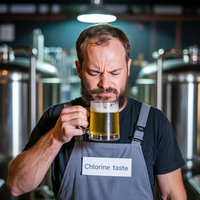Removing Chlorine and Chloramine from Tap Water for Beer Making
Posted by Matteo Lahm and Dale Hynes on 9th May 2025
If you are a homebrewer, you are likely using tap water. If you have had results with plastic, medicinal or band aid off flavors and aromas, chlorine and chloramine are the causes. While brewers can take great care to ensure the mineral balance in their water is correct, not addressing these two compounds will compromise the flavor of your beer. In this article, we will discuss some cheap and easy techniques to remove them.
Water is the primary ingredient in beer, and its quality can have a significant impact on the final product. Chlorine and chloramine are often added to municipal water supplies for disinfection. While these compounds serve an important purpose in maintaining clean drinking water, they are problematic for yeast function.
What Are Chlorine and Chloramine?
Chlorine and chloramine are chemical compounds used by municipal water treatment facilities to disinfect tap water. Chlorine is a powerful disinfectant that kills bacteria and other pathogens in water, while chloramine (a combination of chlorine and ammonia) is a more stable alternative that is also used to ensure water safety over long distances.
Chlorine, in particular, can give beer a distinct "chlorine" or "plastic" taste, while chloramine imparts a more subtle but still undesirable "medicinal" or "band-aid" flavor. Since water accounts for over 90% of beer, any off-flavors from these chemicals can significantly alter the final product, making their removal essential.
You can call your water supplier to find out if both additives are in your water.
How to Remove Chlorine from Brewing Water
If your tap water only contains chlorine, the process for removal is simple. Since chlorine is a volatile compound, it will naturally evaporate when exposed to air. To remove chlorine from your brewing water, you can leave the water out for 24 hours before using it. During this time, the chlorine will dissipate, leaving you with water that's safe for brewing. If you have a brew pot with a spigot, you can just leave it in the pot and drain out the necessary amount to start your boil. Another very useful technique is to leave it in gallon jugs. This is a very good apprach becuase it assists you in measuring along the way.
This method works well for chlorine because it evaporates easily at room temperature. Leave the water uncovered but if you are worried about dust, some cheese cloth will do the trick. By the time you are ready to start your boil, your water should be chlorine-free. However, this approach will not work for chloramine, which is far more stable and does not evaporate as easily.
Dealing with Chloramine
If your water supply contains chloramine, you cannot rely on the same method of simply letting the water sit. Chloramine is much more persistent and requires a more targeted approach to neutralize it.
To effectively remove chloramine from your brewing water, you can use potassium metabisulfite, a common agent used in winemaking and brewing. The recommended dosage for neutralizing chloramine is about 1/4 teaspoon of potassium metabisulfite for every 5 gallons of water or one campden tablet. This should be added 24 hours before you plan to brew. The sulfite will react with the chloramine, breaking it down and rendering it harmless for brewing. You should disolve them in a cup of water prior to adding them to your brewing water.
The Role of Sulfites in Brewing
While using sulfites in beer brewing is often considered a taboo, it's important to understand that the sulfites are not being added to the beer or wort directly. They are only being used to treat the water, and the amount used is minimal. When added 24 hours before brewing, the sulfites will neutralize the chloramine and then begin to lose their potency. By the time the water reaches boiling temperatures to make the wort, the sulfite will have dissipated, and the beer will not be affected.
Additionally, the boiling process itself will help to evaporate sulfur dioxide (SO₂), a byproduct of the sulfite. This ensures that any trace amounts of SO₂ that may be present will be removed, so there is no impact on the fermentation process or yeast activity.
Conclusion
Chlorine and chloramine in tap water can negatively affect the flavor of your beer, but fortunately, we have discussed how easy they are to remove. If you only need to remove chlorine, simply letting the water sit for 24 hours before boiling is an effective solution. However, if your water contains chloramine, you'll need to use potassium metabisulfite to neutralize it. While it may seem unconventional to use sulfites in brewing, this method is safe and ensures that your beer will not be impacted by unwanted flavors. By following these simple steps, you can ensure that your brewing water is free from chlorine and chloramine, helping you brew the best beer possible.

